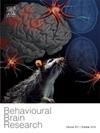Dynamic brain entropy predicts risky decision-making across transdiagnostic dimensions of psychopathology
IF 2.6
3区 心理学
Q2 BEHAVIORAL SCIENCES
引用次数: 0
Abstract
Objectives
Maladaptive risky decision-making is a common pathological behavior among patients with various psychiatric disorders. Brain entropy, which measures the complexity of brain time series signals, provides a novel approach to assessing brain health. Despite its potential, the dynamics of brain entropy have seldom been explored. This study aimed to construct a dynamic model of brain entropy and examine its predictive value for risky decision-making in patients with mental disorders, utilizing resting-state functional magnetic resonance imaging (rs-fMRI).
Methods
This study analyzed the rs-fMRI data from a total of 198 subjects, including 48 patients with bipolar disorder (BD), 47 patients with schizophrenia (SZ), 40 patients with adult attention deficit hyperactivity disorder (ADHD), as well as 63 healthy controls (HC). Time series signals were extracted from 264 brain regions based on rs-fMRI. The traditional static entropy and dynamic entropy (coefficient of variation, CV; rate of change, Rate) were constructed, respectively. Support vector regression was employed to predict risky decision-making utilizing leave-one-out cross-validation within each group.
Results
Our findings showed that CV achieved the best performances in HC and BD groups (r = −0.58, MAE = 6.43, R2 = 0.32; r = −0.78, MAE = 12.10, R2 = 0.61), while the Rate achieved the best in SZ and ADHD groups (r = −0.69, MAE = 10.20, R2 = 0.47; r = −0.78, MAE = 7.63, R2 = 0.60). For the dynamic entropy, the feature selection threshold rather than the time window length and overlapping ratio influenced predictive performance.
Conclusions
These results suggest that dynamic brain entropy could be a more effective predictor of risky decision-making than traditional static brain entropy. Our findings offer a novel perspective on exploring brain signal complexity and can serve as a reference for interventions targeting risky decision-making behaviors, particularly in individuals with psychiatric diagnoses.
大脑动态熵可预测跨诊断层面的精神病理学风险决策
目的 适应不良的风险决策是各种精神障碍患者的常见病理行为。测量大脑时间序列信号复杂性的脑熵为评估大脑健康提供了一种新方法。尽管脑熵具有潜力,但人们很少对其动态变化进行探索。本研究旨在利用静息态功能磁共振成像(rs-fMRI)构建大脑熵的动态模型,并研究其对精神障碍患者风险决策的预测价值。本研究分析了198名受试者的rs-fMRI数据,其中包括48名双相情感障碍(BD)患者、47名精神分裂症(SZ)患者、40名成人注意缺陷多动障碍(ADHD)患者以及63名健康对照组(HC)。根据 rs-fMRI 从 264 个脑区提取了时间序列信号。分别构建了传统的静态熵和动态熵(变异系数,CV;变化率,Rate)。结果我们的研究结果表明,CV 在 HC 组和 BD 组的表现最好(r = -0.58, MAE = 6.43, R2 = 0.32; r = -0.78, MAE = 12.10, R2 = 0.61),而 Rate 在 SZ 组和 ADHD 组的表现最好(r = -0.69, MAE = 10.20, R2 = 0.47; r = -0.78, MAE = 7.63, R2 = 0.60)。这些结果表明,与传统的静态脑熵相比,动态脑熵可以更有效地预测风险决策。我们的研究结果为探索大脑信号的复杂性提供了一个新的视角,可为针对风险决策行为的干预措施提供参考,尤其是针对精神疾病患者。
本文章由计算机程序翻译,如有差异,请以英文原文为准。
求助全文
约1分钟内获得全文
求助全文
来源期刊

Behavioural Brain Research
医学-行为科学
CiteScore
5.60
自引率
0.00%
发文量
383
审稿时长
61 days
期刊介绍:
Behavioural Brain Research is an international, interdisciplinary journal dedicated to the publication of articles in the field of behavioural neuroscience, broadly defined. Contributions from the entire range of disciplines that comprise the neurosciences, behavioural sciences or cognitive sciences are appropriate, as long as the goal is to delineate the neural mechanisms underlying behaviour. Thus, studies may range from neurophysiological, neuroanatomical, neurochemical or neuropharmacological analysis of brain-behaviour relations, including the use of molecular genetic or behavioural genetic approaches, to studies that involve the use of brain imaging techniques, to neuroethological studies. Reports of original research, of major methodological advances, or of novel conceptual approaches are all encouraged. The journal will also consider critical reviews on selected topics.
 求助内容:
求助内容: 应助结果提醒方式:
应助结果提醒方式:


